Class 12: Economics (Microeconomics) Chapter 4 solutions. Complete Class 12 Economics (Microeconomics) Chapter 4 Notes.
Contents
- 1 NCERT Solutions for 12th Class Economics (Microeconomics): Chapter 4-Theory of the Firm under Perfect Competition
- 2 NCERT 12th Economics Chapter 4
- 3 NCERT Solutions for 12th Class Economics (Microeconomics): Chapter 4: Download PDF
- 4 Chapterwise NCERT Solutions for Class 12 Economics (Microeconomics):
- 5 About NCERT
NCERT Solutions for 12th Class Economics (Microeconomics): Chapter 4-Theory of the Firm under Perfect Competition
NCERT 12th Economics (Microeconomics) Chapter 4, class 12 Economics (Microeconomics) chapter 4 solutions
NCERT 12th Economics Chapter 4
1. What are the characteristics of a perfectly competitive market?
A perfectly competitive market exhibits the following characteristics.
i) There are many sellers and buyers in every category.
ii) Multiple choices for similar products.
iii) Sellers or buyers are well-informed and are free to make decisions based on their knowledge of the market.
iv) All the products are homogeneous. Because every product has the same properties, a uniform price can be achieved.
v) There is no price control and the producers can set the prices as per the market demands and supply chains available.
vi) There is no extra cost due to marketing or advertising.
vii) All companies have access to the market without any transport cost.
2. How are the total revenue of a firm, market price, and the quantity sold by the firm related to each other?
The total revenue of a firm is the sum of all revenue earned by the firm. The market price is the price under which the product is sold in the market. In an ideal scenario, the company can control the market price by determining the amount of output that gets sold. And thereby, the company dictates its own scale of revenue.
3. What is the ‘price line’?
A price line or a budget line represents the various combinations and possible quantities of two goods that can be purchased with a given income and assumed prices.
4. Why is the total revenue curve of a price-taking firm an upward-sloping straight line? Why does the curve pass through the origin?
For a price-taking firm, the Average Revenue (AR) is always constant. When AR is constant, Marginal Revenue (MR) is also constant. This means that the Total Revenue (TR) of the firm increases in the same proportion when the price is also constant. Therefore, we see a TR curve that slopes upward as a straight line. When the output level is zero, the TR curve passes through the origin.
5. What is the relation between market price and average revenue of a price-taking firm?
The average revenue of a price-taking firm is equal to its market price.
NCERT 12th Economics (Microeconomics) Chapter 4, class 12 Economics (Microeconomics) chapter 4 solutions
6. What is the relation between market price and marginal revenue of a price-taking firm?
The marginal revenue of a price-taking firm is equal to its market price.
7. What conditions must hold if a profit-maximising firm produces positive output in a competitive market?
The following conditions must be satisfied:
1. Marginal cost should be equal to that of marginal revenue. In other words MC=MR at equilibrium output.
2. Marginal cost should rise above the marginal revenue after exceeding equilibrium output level.
3. The price should be greater than or equal to average variable cost at equilibrium output level (AVC) in short run
4. The price should be greater than or equal to average cost at equilibrium output level in long run.
8. Can there be a positive level of output that a profit-maximising firm produces in a competitive market at which market price is not equal to the marginal cost? Give an explanation
The market price and marginal cost should always be the same for a perfectly competitive firm. So, a positive level of output will not occur when the market price is not equal to the marginal cost.
9. Will a profit-maximising firm in a competitive market ever produce a positive level of output in the range where the marginal cost is falling? Give an explanation.
No, this is not possible. In a perfectly competitive market, the marginal cost curve should keep rising. So, a profit-maximising firm cannot produce a positive level of output when the marginal cost is falling. For a positive level of output, the marginal cost should be rising.
10. Will a profit-maximising firm in a competitive market produce a positive level of output in the short run if the market price is less than the minimum of AVC?
A firm which has its objective of profit maximising under the condition of market price being less than the minimum AVC (average variable cost) will be unable to produce a level of output in the short run because when market price falls to the level of minimum AVC, it indicates that further production cannot be continued and in such a condition a firm is unable to operate.
11. Will a profit-maximising firm in a competitive market produce a positive level of output in the long run if the market price is less than the minimum of AC? Give an explanation.
No, for a profit maximising firm which is operating in a competitive market, producing a positive level of output in the long run with the condition of market price less than AC (Average Cost) is not possible, due to the reason that in the long run there will be free entry and exit of firms and all firms will be earning normal profit. Therefore, a firm will be making losses if market price falls below average cost and in this condition the firm need to stop production.
NCERT 12th Economics (Microeconomics) Chapter 4, class 12 Economics (Microeconomics) chapter 4 solutions
12. What is the supply curve of a firm in the short run?
A firm which is perfectly competitive will have a supply curve that is the summation of the upward sloping part of the short run marginal cost (SMC) when the minimum average variable cost is more than or equal to it and the vertical part of the price axis in a situation where price is less than the minimum average variable cost (AVC).
13. What is the supply curve of a firm in the long run?
In long run there will be no fixed costs as the supply can be changed by changing all the factors of production. Therefore, in a perfectly competitive firm the supply curve will be the summation of upward sloping part of marginal cost that is above the minimum point of average cost in a condition when price is more than or equal to minimum average cost and the vertical portion of price axis in a situation where the price is less than the minimum of average cost. In other words it is that portion of marginal cost curve that lies above the minimum point of average cost curve.
14. How does technological progress affect the supply curve of a firm?
With improvements in technology, the output of the firm achieved with the same amount of capital and labour increases. This lowers the cost of production and also brings down the marginal cost it takes to produce a given quantity of output. The decrease in the marginal cost leads to a rightward and downward shift in the Marginal Cost (MC) curve. Therefore, the firm’s supply curve will also undergo a similar rightward shift.
15. How does the imposition of a unit tax affect the supply curve of a firm?
Unit tax is imposed on per unit of the output which is sold. The impact of unit tax is that the cost of production is increased and as a result there is an increase in marginal cost. Supply falls due to the rising cost which makes the supply curve tilt towards the left.
16. How does an increase in the price of an input affect the supply curve of a firm?
Rise in price of input results in increased cost of production that has a positive impact on rising marginal cost. The impact on MC Curve is that it will shift upward towards left and correspondingly supply curve shifts upwards to the left. There is a negative impact on the supply of the firm as and when input price rises.
17. How does an increase in the number of firms in a market affect the market supply curve?
Increase in number of firms has a direct effect on increasing output of goods. This results in shifting of market supply curve to right.
18. What does the price elasticity of supply mean? How do we measure it?
It is defined as the measure in economics that deals with responsiveness of quantity supplied to a change in price of a good.
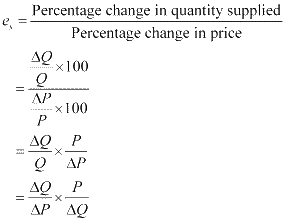
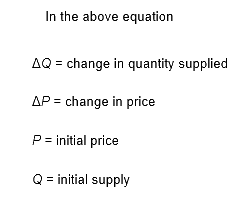
19. Calculate the total revenue, marginal revenue and average revenue schedules in the following table. Market price of each unit of the good is Rs 10.
| Quantity Sold | TR | MR | AR |
| 0 | |||
| 1 | |||
| 2 | |||
| 3 | |||
| 4 | |||
| 5 | |||
| 6 |
The solution is as follows:
P= 10
As per the question
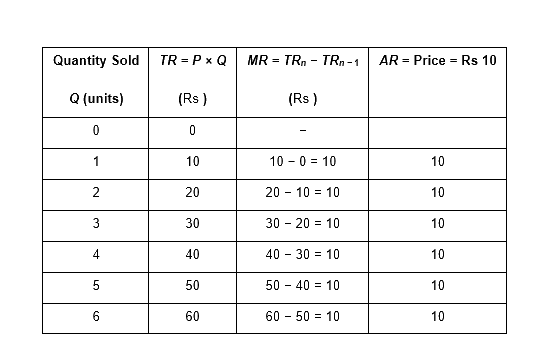
20. The following table shows the total revenue and total cost schedules of a competitive firm. Calculate the profit at each output level. Determine also the market price of the good.
| Quantity Sold | TR (Rs) | TC (Rs) | Profit |
| 0 | 0 | 5 | |
| 1 | 5 | 7 | |
| 2 | 10 | 10 | |
| 3 | 15 | 12 | |
| 4 | 20 | 15 | |
| 5 | 25 | 23 | |
| 6 | 30 | 33 | |
| 7 | 35 | 40 |
The solution is as follows:
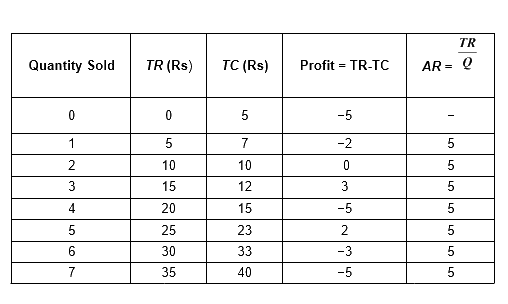
21. The following table shows the total cost schedule of a competitive firm. It is given that the price of the good is Rs 10. Calculate the profit at each output level. Find the profit maximising the level of output.
| Quantity Sold | TC (Rs) |
| 0 | 5 |
| 1 | 15 |
| 2 | 22 |
| 3 | 27 |
| 4 | 31 |
| 5 | 38 |
| 6 | 49 |
| 7 | 63 |
| 8 | 81 |
| 9 | 101 |
| 10 | 123 |
The solution for this question is as follows
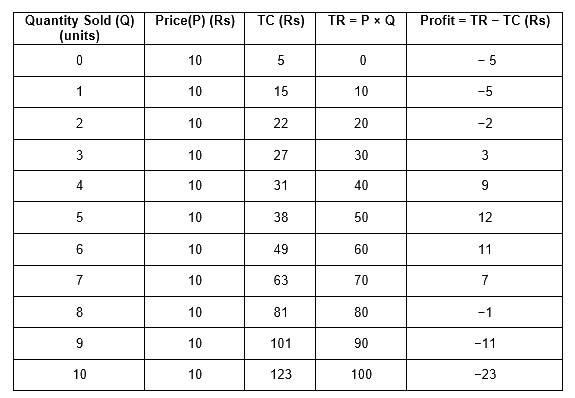
Profit maximization occurs when the difference between revenue and cost is maximum, in the above table it is occurring in 5 units of output and the profit earned is Rs.12
22. Consider a market with two firms. The following table shows supply schedules of two firms: SS1 denotes the supply schedule of firm 1 and SS2 denotes the supply schedule of firm 2. Calculate the market supply schedule.
| Price (Rs ) | SS1 (units) | SS2 (units) |
| 0 | 0 | 0 |
| 1 | 0 | 0 |
| 2 | 0 | 0 |
| 3 | 1 | 1 |
| 4 | 2 | 2 |
| 5 | 3 | 3 |
| 6 | 4 | 4 |
The solution for this question is as follows:
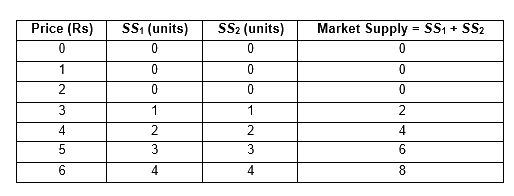
23. Consider a market with two firms. In the following table, columns labelled as SS1 and SS2 give the supply schedules of firm 1 and firm 2 respectively. Compute the market supply schedule.
| Price (Rs ) | SS1 (kg) | SS2 (kg) |
| 0 | 0 | 0 |
| 1 | 0 | 0 |
| 2 | 0 | 0 |
| 3 | 1 | 0 |
| 4 | 2 | 0.5 |
| 5 | 3 | 1 |
| 6 | 4 | 1.5 |
| 7 | 5 | 2 |
| 8 | 6 | 2.5 |
The solution is as follows:
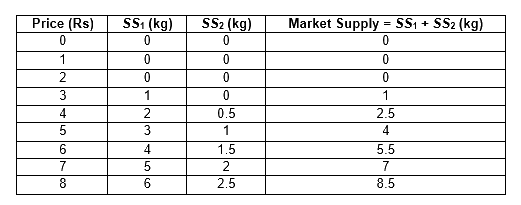
24. There are three identical firms in a market. The following table shows the supply schedule of firm 1. Calculate the market supply schedule.
| Price (Rs ) | SS1 (units) |
| 0 | 0 |
| 1 | 0 |
| 2 | 2 |
| 3 | 4 |
| 4 | 6 |
| 5 | 8 |
| 6 | 10 |
| 7 | 12 |
| 8 | 14 |
As per question, when the three firms are identical, all of them will be having the same supply curve. Market supply will be the sum of all three firms supply output
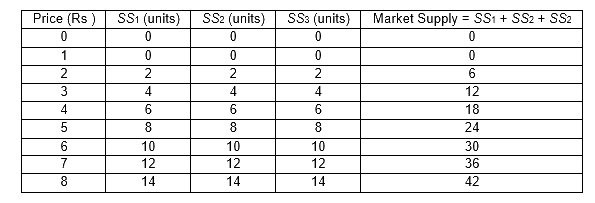
25. A firm earns a revenue of Rs 50 when the market price of a good is Rs 10. The market price increase to Rs 15 and the firm now earns a revenue of Rs 150. What is the price elasticity of the firm’s supply curve?
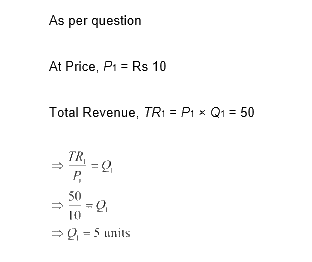
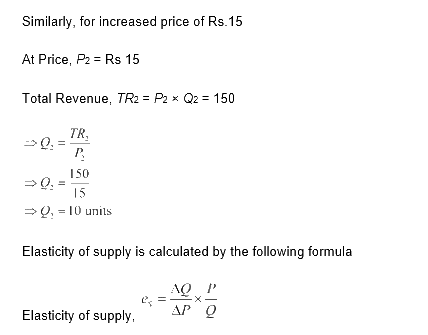
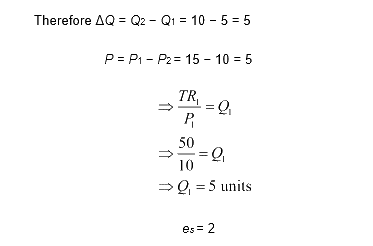
26. The market price of a good changes from Rs 5 to Rs 20. As a result, the quantity supplied by a firm increases by 15 units. The price elasticity of the firm’s supply curve is 0.5. Find the initial and final output levels of the firm.
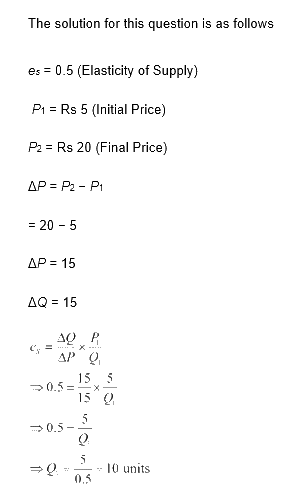
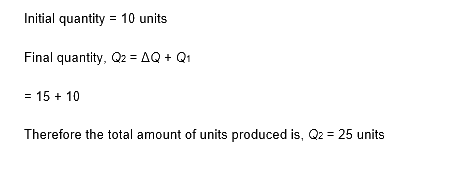
NCERT 12th Economics (Microeconomics) Chapter 4, class 12 Economics (Microeconomics) chapter 4 solutions
27. At the market price of Rs 10, a firm supplies 4 units of output. The market price increases to Rs 30. The price elasticity of the firm’s supply is 1.25. What quantity will the firm supply at the new price?
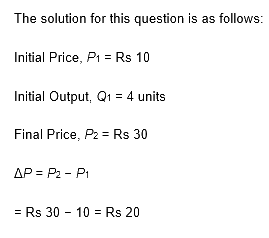
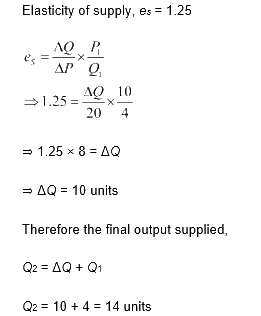
- Perfect Competition – Perfect competition explains a market structure where competition is at its inordinate possible degree. To make it more concise, a market which displays the following characteristic features in its composition is said to show an accurate competition.
- Characteristic features of perfect competition –
- Large number of buyers and sellers
- Homogenous or equivalent product
- Liberty of entry and exit
- Apt mobility
- Great knowledge
NCERT Solutions for 12th Class Economics (Microeconomics): Chapter 4: Download PDF
NCERT Solutions for 12th Class Economics (Microeconomics): Chapter 4-Theory of the Firm under Perfect Competition
Chapterwise NCERT Solutions for Class 12 Economics (Microeconomics):
- Chapter 1 – Introduction to Micro Economics
- Chapter 2 – Theory of Consumer Behaviour
- Chapter 3 – Production and Costs
- Chapter 4 – The Theory of the Firm under Perfect Competition
- Chapter 5 – Market Equilibrium
- Chapter 6 – Non-competitive Markets
About NCERT
The National Council of Educational Research and Training is an autonomous organization of the Government of India which was established in 1961 as a literary, scientific, and charitable Society under the Societies Registration Act. Its headquarters are located at Sri Aurbindo Marg in New Delhi. Visit the Official NCERT website to learn more.
